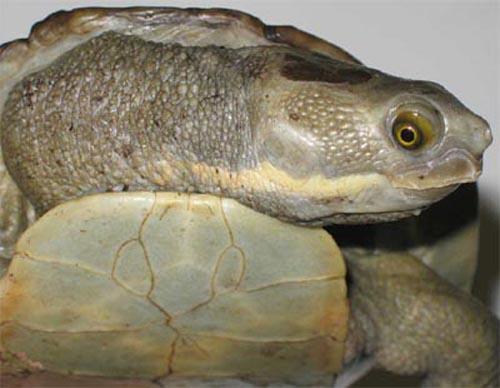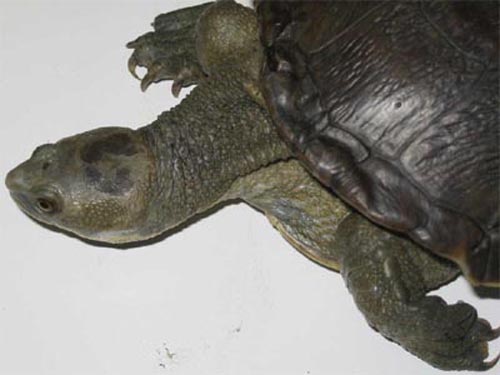Macquarie Turtle -- Emydura macquarii macquarii
[3]

Breeding
Mating of E. macquarii macquarii has been observed
from March to April (Cann 1998). Nesting occurs between late October and
mid-December, and females generally produce only one clutch of 15-35 eggs
per year (Chessman 1978, Spencer 2001). According to Thompson (1983), the
mean clutch size is 22 eggs. Emydura macquarii macquarii has a
bimodal daily nesting activity with peaks occurring near dawn and dusk.
Females prefer to nest during or after rainfall (Spencer, 2002). Nest are
subject to strong predation by birds, primarily Australian Bell Magpies
(Gymnorhina tibicen), and foxes (Vulpes vulpes) (Spencer,
2002). A study of nesting along the Murray found that 96% of nests of E.
macquarii had been depredated, mainly by foxes but also by water-rats,
goannas, and ravens (Thompson 1983).
Right photograph [4]: Female E. m. macquarii
The natural incubation lasts about 78 days (Goode, 1965) while the artificial incubation can be shortened down to 48 days at the constant temperature of 30°C (Thompson, 1984). Of course eggs deposited in a natural nest experience wide daily fluctuations in temperature [up to 12°C] and nest temperatures are higher later in the season than earlier (Thompson, 1988).
E. macquarii macquarii males sexually mature at 5-6 years while
females mature at 9-11 years (Spencer, 2001).
Synonyms of Emydura macquarii macquarii
|
Bottom photograph [5]: E. m. macquarii
 In captivity
In captivity
Emydura macquarii macquarii is probably
one of the most common Emydura species occurring in captivity.
Unlike other Emydura species who inhabit subtropical or tropical regions,
E. macquarii macquarii is a "temperate climate turtle".
The Emydura species in general require a relatively large aquarium
or a pond because they all are excellent and fast swimmers. Outdoor
setups, where captive specimens can get direct sun and have plenty of
room to move around are an ideal choice. If your climate does not allow
you to keep your specimens outdoors, a spacious indoor tank may also
be used. The temperature of the water should not exceed 25°C. The optimal
range is between 18-23°C. Alkaline water (pH of 7.5-8.0) is recommended.
Both animal and plant matter should be fed. Juveniles might prefer eating
animal matter, but as they mature, they show more and more interest
in plant matter. If kept outdoors, the water temperature in winter should
not drop below 5°C. Hibernation in winter may occur but not necessarily.
Indoors, where a constant temperature is regulated by a heater, hibernation
does not take place. I do not recommend keeping this species with other
Chelidae than those that occur in sympatry (i.e. Chelodina
longicollis).
